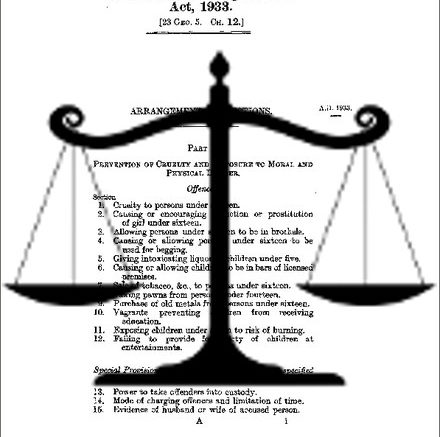The primary piece of legislation that governs the treatment of young people in Britain is the Children and Young Persons Act 1933 (CYPA). This Act contains much that relates to matters pertaining to child cruelty and was one of keynote reforming acts of the British government in the 20th century.
This act also places the rights of the young person at the centre of concern and this is very evident in how the CYPA deals with the matter of identification of juvenile criminals. The CYPA takes the view that identifying young criminals may hamper them in later life when they may have matured as individuals and may no longer be liable or likely to commit further criminal offences. There’s a lot of logic in this thinking, there are many people who when young and immature, are complete arseholes and some may commit criminal offences that should not cause them problems later on when they have grown out of their criminality phase.
However, the world has moved on and maybe it is time to look again at some of the provisions of the CYPA and ask ourselves whether it is still appropriate to have a blanket ban on the naming of criminals who are under the age of eighteen. Of course, I still think that where young people are the victims or alleged victims of crime such as sexual abuse or robbery or similar offences then it’s probably right for them to be shielded from press attention, but should this protection continue to be extended to those young people accused of or convicted of crimes, especially serious ones? I am coming round to the view that maybe this should not be the case. Should it not be the case that rather than all the focus of protection being on the criminal or alleged criminal that the focus should of protection be instead on the wider community?
The reasons for me asking these questions and for writing this piece comes from an article over at the Ambush Predator blog. In the Ambush Predator article the author JuliaM details the case of an appalling dog killing thug who is not only likely to escape what many readers may say is a justifiable custodial sentence, but whose identity is being hidden from people by the provisions of CYPA. I’ve looked into the source that Ambush Predator used and it tells a story that strengthens my belief that it’s time, for reasons of community protection, for the blanket bans on naming young offenders to be either removed completely or significantly curtailed. As is usual policy for this blog the original source that Ambush Predator has used is in italics whereas my comments are in plain text.
Ambush Predator quoted from a story on Gloucestershire Live which said:
A 14-year-old boy kicked and punched to death a family’s beloved pet dog after losing his temper, a court was told.
Whilst I accept that some teenagers can be a little hair triggered and prone to temper tantrums, this does look like a bit of an excessive reaction to the situation. It’s so seemingly excessive that it makes me wonder what sort of home life this teenager has had and it makes me wonder if is he going to be a threat to life and limb in the future?
The teenager launched the savage assault on the Staffordshire bull terrier in St Ives, Cornwall, in October of last year, reports Cornwall Live .
The defendant, who can’t be named, is said to have become irate after the dog, called Teddy, pinned down his own dog.
There’s no indication in the story whether the Teddy was biting the other dog or whether, as I’ve seen well trained Staffies do in the past, engaging in play fighting? The teenager’s reaction to this ‘pinning down’ and the violence that he meted out to the dog does look exceedingly over the top.
Teddy suffered a fractured skull and multiple blunt-force injuries to his head, neck and torso and the boy was convicted of causing unnecessary suffering to a protected animal.
The description of the injuries to Teddy suggest that the teenager used far more force than may have been necessary to separate the dogs. I wonder how long it will be before this teenager does the same sort of thing to a human being, bearing in mind his apparent readiness to engage in acts of extreme violence to an animal?
The boy’s father, who cannot be named for legal reasons, was cleared of an identical charge.
The defendant, who also cannot be named and has since turned 15, will be sentenced on August 22 after a report on him is produced by the youth offending team.
So both the father and the son were charged with these offences although the father was acquitted. Yet neither of them can be named as naming the father would automatically identify the son. Personally I think that because of the severity of this incident there is a case to be made that naming this family may help local people to avoid them and avoid conflict with them in the future. I wonder how many other animals or people this teenager is going to injure or kill because people are unaware of the identity of this particular teenager? Naming this teenager and his family is in my view a community safety issue. If I lived in that area I’d want to know who the junior psychos in my area are and not have their identity hidden from me by the courts.
District Judge Diana Baker warned the teenager would be going straight down those steps to custody if he was an adult.
So it looks, based on the district judge’s comments, as if this junior dog killer will be out on the streets and be given a non-custodial sentence. I suspect that the reports into this boy’s background will not recommend that he his caged and instead will recommend some form of non-custodial sentence.
“This is at the highest level of animal cruelty,” she said, as reported by the BBC . “It is a persistent attack on a dog, causing the ultimate injury, death, by kicking and punching.”
If this case and this attack is so bad, why isn’t he immediately going down? It doesn’t sound as if there are any credible mitigating factors, even the RSPCA prosecutor was able to say that this particular Staffie was not a dangerous or threatening dog and was apparently according to both the prosecutor and Teddy’s owner, well trained.
Whilst I can see the reasoning for the blanket restrictions on naming juveniles charged with criminal offences it is cases like these that should make us debate whether this blanket ban is still appropriate. In my view, preserving the safety of the law abiding majority by allowing them to know who these junior criminals are should take precedence over protecting the anonymity of the minor criminal. This case, or rather the inability to name the offender, puts law abiding people and their property, including their animals at risk. It is now long past time for there to be a reconsideration about whether forbidding the naming of the feral young people that our society seems to produce in abundance, is good for either the offender or for society as a whole. It’s time for public protection reasons, for juvenile criminals and those juveniles accused of serious criminal offences to be named. The anonymity provisions for juvenile criminals contained in the 1933 Children and Young Persons Act are now more of a hindrance to justice rather than an asset to justice. I find myself agreeing with Ambush Predator that there’s a good chance that this District Judge may come to regret her leniency and I say that the law abiding people of St Ives in Cornwall will also come to regret the anonymity given to this appalling young criminal.






“..although the father was acquitted. “
It doesn’t say that, it says ‘cleared’. It may be clumsy phrasing, but it may also be that the judge directed he had no case to answer. I can’t find anything about his trial, probably because they didn’t want to name the ‘child’.
I’ve seen ‘cleared’ used in press reports to cover both acquitted by a jury or at the direction of a judge because the Crown’s case is so poor. I agree that it is unclear and this unclarity illustrates what I mean when I say that the CYPA 1933 identification bans is doing more harm to society than it is helping the juvenile offender as it hides major aspects of the administration of justice. These naming bans mean that although justice may be being done, we the public are not seeing it being done.